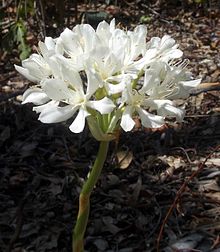Proiphys amboinensis
1. Proiphys amboinensis (L.) Herb., Appendix: 42. 1821. Type:
Pancratium amboinense L., Sp. Pl.: 291. 1753. Type: ???
Eurycles sylvestris Salisb., Trans. Hort. Soc. London 1: 337. 1812.
Cearia amboinensis (L.) Dumort., Comment. Bot.: 65. 1822.
Eurycles amboinensis (L.) Lindl. ex Loudon, Encycl. Pl.: 242. 1829.
Herbs, perennial; bulbs 5–8 cm diam. Leaves cordate to suborbicular, 20–30 long, 15–35 cm broad¬; base cordate; margin entire or slightly undulate; apex emarginate sometimes shortly epiculate; petioles 15–40 cm long. Umbel 10–25-flowerd; peduncle 15–50 cm long; spathes 3–4, 3–8 cm long. Flowers pedicellate. Tepals united into a narrow tube; segments subequal, erect to patent, elliptic to obovate, apiculate. Stamens inserted in the throat, basally connected by membrane which is deeply bilobed between filaments and shorter than tepals; anthers medifixed or versatile, Ovary with 2 ovules per locule; style filiform; stigma entire, small. Fruit dry or slightly fleshy, rupturing irregular, Seeds globose, green.
Thailand.— NORTHERN: Mae Hong Son, Lampang; NORTH-EASTERN: Nong Khai; CENTRAL: Uthai Thani, Krung Thep Maha Nakhon.
Distribution.— Thailand to northern Australia.
Ecology.— In mixed deciduous forest, commonly cultivated as ornamental plant.
Vernacular.— Wan Nok Kum (ว่านนกคุ้ม).
Specimens examined.— A. Chantanamuck 491 (BK); Kasem 386 (BK); A.F.G. Kerr 1601 (BK), 5484 (BK); J.F. Maxwell 76-304 (BK), 90-610 (CMU), 96-619 (BKF).
